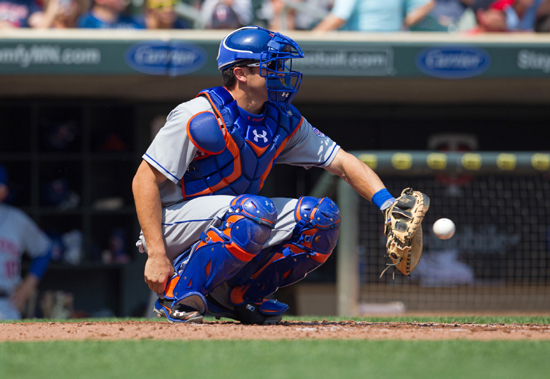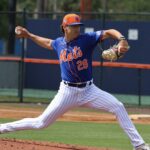
The following is an in depth look at Travis d’Arnaud’s overall value as a catcher. The idea that he is incapable of being an everyday backstop is based on two conventional defensive metrics. The lack of credit surrounding his framing skills leaves something to be desired though. Stolen bases and passed balls rarely result in a run scored for the opposition, yet a framed pitch always produces a positive effect. The two fold advantage of a called strike versus a ball can be felt by the opposition, the pitching staff, the offense, even the entire division. If weighted properly, what could the value of d’Arnaud’s framing skills mean for his future and that of the NY Mets?
Scott Lindholm from Beyond The Box Score did an excellent job collecting and analyzing stolen base data that was recorded from 1950-2010 (Tom Tango – “Run Expectancy Matrix”) only to find that over the last 60+ years, stolen base attempts have proven largely inefficient. The Kansas City Royals did make it to the World Series last year as the only MLB team with more stolen bases than home runs, so I do understand that the art of thievery has its rightful place in the game. However, take a look at some of the following statistics as they pertain to d’Arnaud.
A runners best odds of stealing first to second are when there are zero outs, yet doing so only increases the opposition’s odds of scoring a run by 20%. Take a moment to appreciate the inverse of that statement. That means that at least 80% of the time second base is stolen, it’s unlikely to result in a run scored- 80%. Granted, these numbers only go up to 2010, but 60 years of data is a reasonable sample size to support the last four seasons.
The matrix also shows that having a solid caught stealing rate behind the plate significantly decreases the oppositions odds of scoring a run in that inning – it sounds obvious, but look at what I mean. From 1993-2010, throwing out the runner at second actually decreased the opposition’s chances of scoring a run, in that inning, by 26.3%. It’s only fair to point out that improvements in this area can offer significant upside.
The runner’s success increases greatly as he progresses around the diamond, but to be honest, throws to third base are infrequent and d’Arnaud has already shown excellent positioning and execution with home plate defense. The attempts on second base from first are the real issue, but it’s very reasonable to expect vast improvements after a full offseason of training.
Defense, aside from pitch framing, was a priority for d’Arnaud, even when he was still with the Toronto Blue Jays. While reading a pitch blocking analysis on TDA (Amazin’ Avenue), I noticed an excerpt from Baseball America back in 2012:
“d’Arnaud made good strides with his defense in 2011 by working with then-New Hampshire manager Sal Butera, who caught in the majors for nine seasons. Those improvements carried over to 2012, when d’Arnaud threw out a career-high 30 percent of basestealers. He has average to plus arm strength and has refined his footwork and throwing accuracy.”
If the opposition steals a base, it’s worth a 20% in their favor. If d’Arnaud throws them out, it’s worth 26.3% in the Mets favor. Point being, he needs to improve his 19% caught stealing rate because the positive upswing holds a lot of value, but shows a history of improving in this area. Working with Mike Barwis will improve his explosiveness and the surgically removed bone chips in his throwing elbow will certainly improve the accuracy of his throws. As far as last year’s stats though, this narrative that base runners will cost him his job is such a stretch.

Also on Beyond the Box Score was a great piece by Rob Castellano, who wrote about the value of d’Arnaud’s pitch blocking, or lack thereof, except unlike many- he compared that value to impact of his pitch framing skills. The net value is surprisingly positive, enough to make you wonder how so many justified knocking his flaws when the upside to his best attribute is so high.
D’Arnaud is adept at controlling the very bottom of the strike zone. Castellano offers a reasonable explanation for the young backstop’s elevated number of passed pitches by comparing TDA’s skills to one of framing’s original pioneers, Jose Molina, during his time with the Tampa Bay Rays.
“In short, there seems to be an element of robbing Peter to pay Paul when it comes to framing pitches, except teams like the Rays have realized that Paul brings back much higher rates of return…d’Arnaud keeps on calling for those breaking balls in the dirt, difficult to block though they may be, because those are also the pitches he’s going to have the best chance to ‘steal’ from his opponent”
In the article, Costellano included an analysis by Max Marchi (Baseball Prospectus) on the run value for blocked versus framed pitches. From 2008-2011, Carlos Ruiz was considered the best pitch blocking catcher in MLB with 9.5 blocking runs created.
However, what’s interesting is the stark difference in value for catchers who focus more on framing. During that same four year period, Brian McCann was the best framing catcher, generating 79.3 runs with his glove work. Costellano adds:
“Based on linear weights, the very best framers were worth, on average, over ten times as many runs as the top blockers.”
Current advanced catching metrics on Baseball Prospectus are built further on the work that Marchi did, but still stay consistent with the weight he applied.
In 2014, d’Arnaud was worth -2.7 blocking runs for the 22 passed pitches (passed balls + wild pitches) assigned to him, but added 11.2 runs off of the 75.1 extra strikes he created. That means d’Arnaud was worth a net of +8.5 runs based on framing alone.
These results in other areas of the NY Mets though, particularly the young starters Zack Wheeler and Jacob deGrom.
August Fagerstrom (FanGraphs) evaluated Zack Wheeler’s historic 0-2 hit(less) streak that went deep into the month of August (couldn’t have written in September?). Fagerstrom credited the increased effectiveness of Wheelers breaking pitches down in the zone as the catalyst for his hitless streak. Granted, most pitchers perform at their best in 0-2 counts, but Wheeler was in the midst of what may have been a major league record had the data gone back far enough to prove it.
Zack produced some of the best results in the league with his curveball and slider once he was paired up permanently with TDA:
Wheeler appears to have more confidence in his slider. He appears to have more confidence in his curve. Both for good reasons. You can see these changes reflected in his two-strike heatmaps…his highly-praised curveball is up to 33% from 27% last year and his whiff percentage has gone from 10% to 15%. Now, that curveball finds itself on the other side of the spectrum, grading out as a top-25 curveball.
Also…
“Wheeler has doubled the use of his slider against left-handed batters, from 6% to 12%. That’s good, because lefties have gotten exactly one hit off Wheeler’s slider this year [as of August 28th]. 14 of the 28 strikeouts Wheeler has generated with the slider have come against lefties.”
It’s nearly impossible to say that d’Arnaud didn’t directly impact those results, Wheeler has even said himself:
“He’s just smooth back there…when the balls are down, he does something that makes them look like they’re strikes.”
With a full season behind the plate, d’Arnaud could increase his framing value significantly. The most efficient way to do it would be to up that value, while also decreasing the number of passed balls. As Costellano pointed out, he has a preference for breaking balls in the dirt in order to ‘steal’ that strike from the hitter, but fastballs are a lot easier to catch and his framing skills are perfect for stealing heaters located just below the bottom of the zone.
Fastball location is the staple of any power pitcher’s arsenal (i.e., the very foundation by which this organization is built on). Wheeler, deGrom and Matt Harvey all rely on the pitches down in the zone to strikeout hitters and according to Noah Syndergaard’s recent interview with SNY, this is what the Mets are looking to see from him before he earns a promotion. It’s also the reason why many see Steven Matz as a candidate to challenge Syndergaard for a promotion. Pitching down in the zone has earned him praise at such an early stage in his career.
Take a look at that ESPN heat map again and keep that horseshoe figure in mind when you watch this clip of deGrom’s 13 strikeout performance against the Miami Marlins. TDA had a 2.65 cERA with deGrom on the year and much of that had to do with the deceptive location of Jacob’s two and four seam fastballs. If d’Arnaud can replicate this type of game calling with Harvey, Wheeler and eventually Syndergaard and Matz – the ceiling for his glove is very high.
Hopefully the idea here is starting to become clearer. The Mets have a healthy crop of power pitchers who attack the bottom of the strike zone regularly with high 90’s fastballs and slick breaking pitches. When it comes to this organizations most prized assets, the arms we’ve all been waiting for, TDA is subtly maximizing their value.
Lastly, I want to make good on that comment I made about the division. Costellano also included a piece by Jeff Sullivan (Grantland), which calculated the called strike effect on all 30 teams in baseball last year. Basically, there were teams who benefited greatly from pitch framing, teams who suffered from it and those somewhere in the middle.
The NL, with the exception of the Mets, is baron in terms of framing catchers. This makes the effect of d’Arnaud’s glove incredibly significant, again with a two-fold effect. He’s able to steal from the opposition, while the rest of the division finds themselves being robbed and unable to return the favor.
The Mets benefited from the fifth highest positive total, registering 147 strikes in their favor. The rest of the NL East experienced much less of an advantage. The Phillies (+33), Nationals (-92), Braves (-197) and Marlins (-262) were far behind the Amazins and the impact is definitely significant. Consider the difference from the top and bottom teams in the whole league:
“What does a single strike mean? Calculations in the past have put the value of an extra strike somewhere around 0.14 runs. That’s not very much, but then, you can do the multiplication. These things add up fast. If you use that estimate, then the difference between the Brewers and the Blue Jays, here, comes out to about 95 runs, just from pitch-framing alone.”
Ok, so the difference isn’t that beneficial for the Mets, but using those calculations, I was able to derive run differential enjoyed by the Mets by comparison to their divisional opponents. NY had a 16 run advantage over the Phillies, 34 run advantage over the Braves, 48 runs over the Nationals and 57 runs over the Marlins.
There are a number of studies on the number of runs equal to a win, but the general consensus is between 10-11 runs per 1 win. Using conservative estimates (11 runs/Win), pitch framing gave the Mets a 4 win advantage over the Nationals last year and a 5 win advantage over the Marlins. It’s going to be a tight race against those bottom two teams specifically, that kind of win advantage could be the difference in the division title.
I wrote about d’Arnaud’s offensive upside earlier this year and that, combined with what I was able to take out of the above, tells me this. For once, the Mets landed in the right place, with the right players, at the right time.














